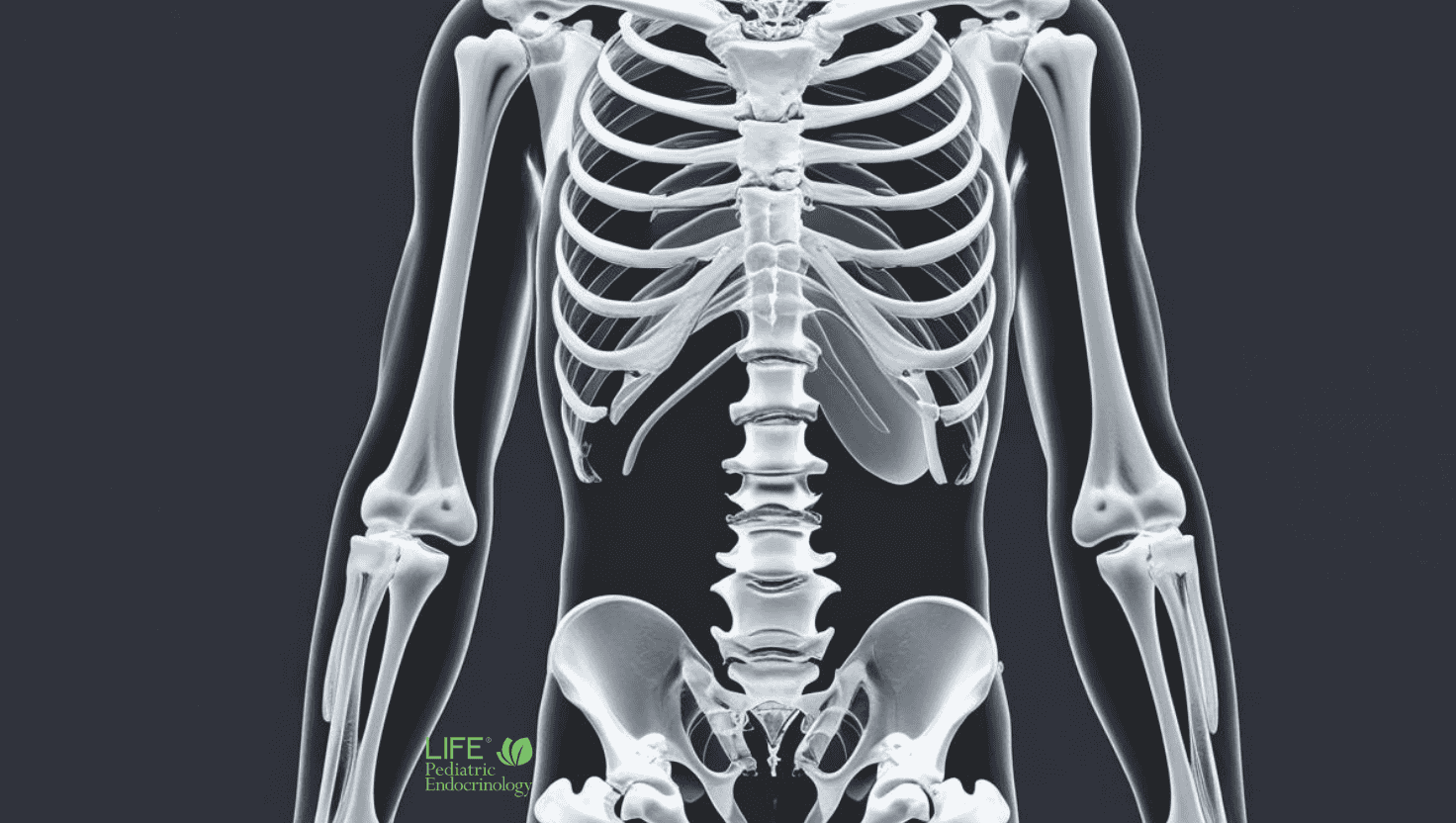What Is Brittle Bone Disease? Osteogenesis Imperfecta Explained
By Dr. Kelli Davis, Pediatric Endocrinologist at Life Pediatric Endocrinology
Introduction
As a pediatric endocrinologist specializing in metabolic bone disease, I often meet families searching for answers after their child has experienced frequent fractures or been given the term “brittle bone disease.” The medical name for this condition is osteogenesis imperfecta (OI).
OI is rare, complex, and lifelong—but with the right knowledge, care, and team approach, children can grow, thrive, and live meaningful lives. In this article, I’ll explain what brittle bone disease is, why it happens, how it affects children, and what families should know about diagnosis and treatment.
What Is Brittle Bone Disease (Osteogenesis Imperfecta)?
Brittle bone disease, or osteogenesis imperfecta, is a group of inherited connective tissue disorders that cause fragile bones that break easily—even from minimal trauma.
The hallmark problem in OI is defective type I collagen, an essential protein that provides structure and strength to bones. In most cases (80–85%), OI is caused by mutations in the COL1A1 or COL1A2 genes, inherited in an autosomal dominant pattern. However, newer research has revealed that OI can also be caused by other genes that affect collagen production, bone mineralization, and osteoblast (bone cell) function, resulting in autosomal recessive or even X-linked forms of the disease .
Types of Brittle Bone Disease
Doctors classify OI into types, which reflect severity and clinical features:
-
Type I – Mildest and most common. Children may have frequent fractures, blue sclera (the whites of the eyes appear bluish), and normal or near-normal height.
-
Type II – The most severe and often lethal form, diagnosed at or before birth.
-
Type III – Severe, progressively deforming OI. Children often have multiple fractures, bone deformities, and significant short stature.
-
Type IV – Moderate severity. Children may have fractures, mild bone deformities, and variable short stature.
Today, scientists have identified more than 20 genetic subtypes of OI, reflecting the complexity of its molecular pathways .
Symptoms Beyond Fragile Bones
While fractures are the most visible sign, OI can affect much more than bones:
-
Skeletal: Short stature, scoliosis, bowing of long bones.
-
Dental: Dentinogenesis imperfecta (weak, discolored teeth).
-
Hearing: Progressive hearing loss in adolescence or adulthood.
-
Muscle & joints: Muscle weakness, joint hypermobility.
-
Other systems: Cardiopulmonary complications in severe forms.
This wide range of symptoms underscores why OI care requires a multidisciplinary approach.
How Is Brittle Bone Disease Diagnosed?
Diagnosis usually involves a combination of:
-
Clinical history and physical exam (fracture pattern, family history).
-
Imaging studies such as X-rays or bone density scans.
-
Genetic testing, which is now considered the gold standard, allowing for precise diagnosis and counseling.
It’s important to note: frequent fractures in children are sometimes mistakenly attributed to child abuse. The American Academy of Pediatrics stresses careful evaluation to distinguish OI from non-accidental trauma .
Treatment Options
Currently, there is no cure for brittle bone disease—but treatment can dramatically improve quality of life.
Medical therapies include:
-
Bisphosphonates – Medications that strengthen bones and reduce fracture risk.
-
Hormonal & metabolic support – Addressing vitamin D, calcium, and endocrinologic balance.
-
Emerging therapies – Research is exploring stem cell transplantation, gene therapy, and novel bone-active medications.
Non-medication approaches:
-
Physical therapy & safe exercise – To improve muscle strength and mobility.
-
Orthopedic care – Surgical rods or bracing for bones prone to deformity.
-
Dental & audiology care – To address OI’s effects beyond the skeleton.
At Life Pediatric Endocrinology, my approach is integrative—not only using proven medical treatments but also considering nutrition, lifestyle, and long-term growth potential for each child.
Living With Brittle Bone Disease
Children with OI are more than their diagnosis. With early intervention, a coordinated care team, and family support, many children walk, attend school, play sports safely, and lead fulfilling adult lives.
Parents should know: every fracture is not a setback, but an opportunity to reinforce care strategies. Empowering families with knowledge, access, and personalized guidance is central to my practice philosophy.
Key Takeaways
-
Brittle bone disease (osteogenesis imperfecta) is a genetic disorder of collagen that causes fragile bones and frequent fractures.
-
Severity ranges from mild to lethal, with 20+ genetic subtypes identified.
-
Management requires a multidisciplinary, integrative approach—combining medication, physical therapy, surgery, and lifestyle care.
-
Advances in genetics and therapies are bringing new hope for children and families.
FAQ: What Is Brittle Bone Disease (Osteogenesis Imperfecta)?
1) What is brittle bone disease?
Brittle bone disease—also called osteogenesis imperfecta (OI)—is a genetic connective-tissue disorder that causes fragile bones that break easily.
2) What causes OI?
Most cases are due to changes in the COL1A1 or COL1A2 genes, which affect type I collagen. Other rare genetic causes alter collagen processing, bone formation, or mineralization.
3) How common is OI?
OI is rare, affecting roughly 1 in 10,000–20,000 births worldwide. The severity can range from mild to life-threatening.
6) How is OI diagnosed?
Diagnosis includes a detailed history, imaging such as X-rays or bone density testing, and confirmatory genetic testing to identify the subtype and guide treatment.
8) How is OI treated?
Treatment is personalized and may involve bisphosphonates, vitamin D and calcium optimization, physical therapy, orthopedic procedures, and coordinated care. Research is ongoing into newer therapies like stem cell and gene-based treatments. At Life Pediatric Endocrinology, Dr. Kelli Davis' Metabolic Bone Disease Program provides integrative treatment options for children with osteogenesis imperfecta.
10) Will my child outgrow OI?
No. Osteogenesis imperfecta is lifelong, but early diagnosis, fracture prevention, and a multidisciplinary care plan help children live active, fulfilling lives.
References
-
Jovanovic M, Guterman-Ram G, Marini JC. Osteogenesis Imperfecta: Mechanisms and Signaling Pathways Connecting Classical and Rare OI Types. Endocrine Reviews. 2022;43(1):61-90. doi:10.1210/endrev/bnab017.
-
Botor M, Fus-Kujawa A, Uroczynska M, et al. Osteogenesis Imperfecta: Current and Prospective Therapies. Biomolecules. 2021;11(10):1493. doi:10.3390/biom11101493.
-
Jovanovic M, Marini JC. Update on the Genetics of Osteogenesis Imperfecta. Calcified Tissue Int. 2024;115(6):891-914. doi:10.1007/s00223-024-01266-5.
-
Haney S, Scherl S, DiMeglio L, et al. Evaluating Young Children With Fractures for Child Abuse. Pediatrics. 2025;155(2):e2024070074. doi:10.1542/peds.2024-070074.
-
Marom R, Rabenhorst BM, Morello R. Osteogenesis Imperfecta: An Update on Clinical Features and Therapies. Eur J Endocrinol. 2020;183(4):R95-R106. doi:10.1530/EJE-20-0299.
-
Yu H, Li C, Wu H, et al. Pathogenic Mechanisms of Osteogenesis Imperfecta. Orphanet J Rare Dis. 2023;18(1):234. doi:10.1186/s13023-023-02849-5.
-
Garibaldi N, Besio R, Dalgleish R, et al. Dissecting the Phenotypic Variability of Osteogenesis Imperfecta. Dis Model Mech. 2022;15(5):dmm049398. doi:10.1242/dmm.049398.
-
Arshad F, Bishop N. Osteogenesis Imperfecta in Children. Bone. 2021;148:115914. doi:10.1016/j.bone.2021.115914.
Share this
You May Also Like
These Related Stories

What Is Bone Disease? Understanding Causes, Symptoms, and Treatments

What Are The Symptoms of Bone Disease?


